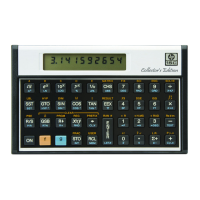Section 2: Numeric Functions 29
Two-Number Functions
The HP 15c performs two-number math functions using two values
entered sequentially into the display. If you are keying in both numbers,
remember that they must be separated by v or any other
function—like | ‘ or ⁄—that terminates digit entry.
For a two-number function, the first value entered is considered the y-
value because it is placed into the Y-register for memory storage. The
second value entered is considered the x-value because it remains in the
display, which is the X-register.
The arithmetic operators, +, -, *, and ÷, are the four basic two-
number functions. Others are given below.
The Power Function
Pressing y calculates the value of y raised to the x power. The base
number, y, is keyed in before the exponent, x.
To Calculate
Keystrokes Display
2
1.4
2 v 1.4 y
2.6390
2
−1.4
2 v 1.4 ” y
0.3789
(−2)
3
2 ” v 3 y
-8.0000
2
3
or 2
⅓
2 v 3 ⁄ y
1.2599
Percentages
The percentage functions, k and ∆, preserve the value of the original
base number along with the result of the percentage calculation. As
shown in the example below, this allows you to carry out subsequent
calculations using the base number and the result without re-entering the
base number.
Percent. The k function calculates the specified percentage of a base
number.

